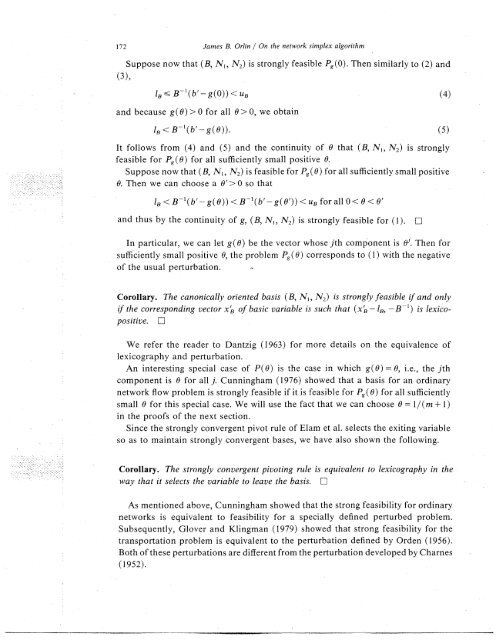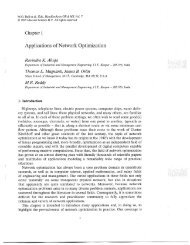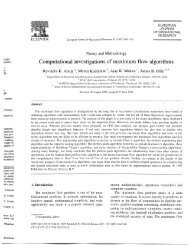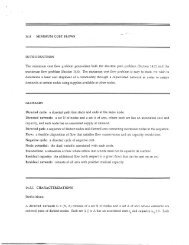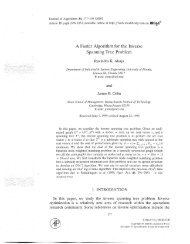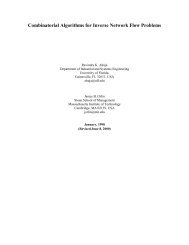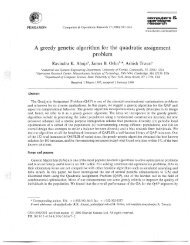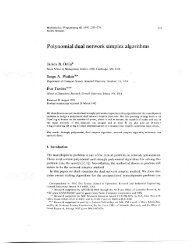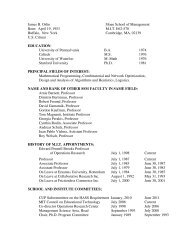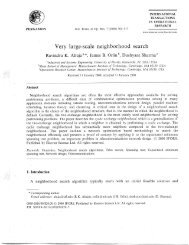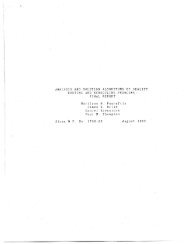ON THE SIMPLEX ALGORITHM FOR NETWORKS ... - James B. Orlin
ON THE SIMPLEX ALGORITHM FOR NETWORKS ... - James B. Orlin
ON THE SIMPLEX ALGORITHM FOR NETWORKS ... - James B. Orlin
Create successful ePaper yourself
Turn your PDF publications into a flip-book with our unique Google optimized e-Paper software.
172<br />
<strong>James</strong> B. <strong>Orlin</strong> / On the network simplex algorithm<br />
Suppose now that (B, N 1 , N2) is strongly feasible Pg(O). Then similarly to (2) and<br />
(3),<br />
IB s B-(b'-g(O)) < UB (4)<br />
and because g(0)> 0 for all 0 > 0, we obtain<br />
1 < B-'(b'- g(0)). (5)<br />
5'*<br />
..' .·!<br />
-·1··..··. ·:·:.-·c··:..·.··.<br />
··.··.-..·.. ··..-<br />
· ·.·.- .·.·( ,<br />
·; :·,<br />
It follows from (4) and (5) and the continuity of 0 that (B, N 1 , N2) is strongly<br />
feasible for Pg(O) for all sufficiently small positive 0.<br />
Suppose now that (B, N 1 , N2) is feasible for Pg(O) for all sufficiently small positive<br />
0. Then we can choose a '> 0 so that<br />
IB < B- 1 (b' - g()) < B-(b' -g(0')) < uB for all 0< 0 < '<br />
and thus by the continuity of g, (B, N 1 , N2) is strongly feasible for (1).<br />
In particular, we can let g(0) be the vector whose jth component is '. Then for<br />
sufficiently small positive 0, the problem Pg(O) corresponds to (1) with the negative<br />
of the usual perturbation.<br />
;'-·i<br />
·C'<br />
·,<br />
Corollary. The canonically oriented basis (B, N 1 , N2) is strongly feasible if and only<br />
if the corresponding vector x of basic variable is such that (x - , -B - ') is lexicopositive.<br />
1<br />
We refer the reader to Dantzig (1963) for more details on the equivalence of<br />
lexicography and perturbation.<br />
An interesting special case of P(8) is the case in which g(8)= 0, i.e., the Jth<br />
component is 0 for all j. Cunningham (1976) showed that a basis for an ordinary<br />
network flow problem is strongly feasible if it is feasible for Pg(0) for all sufficiently<br />
small 0 for this special case. We will use the fact that we can choose 0 = 1/(m + 1)<br />
in the proofs of the next section.<br />
Since the strongly convergent pivot rule of Elam et al. selects the exiting variable<br />
so as to maintain strongly convergent bases, we have also shown the following.<br />
Corollary. The strongly convergent pivoting rule is equivalent to lexicography in the<br />
way that it selects the variable to leave the basis.<br />
As mentioned above, Cunningham showed that the strong feasibility for ordinary<br />
networks is equivalent to feasibility for a specially defined perturbed problem.<br />
Subsequently, Glover and Klingman (1979) showed that strong feasibility for the<br />
transportation problem is equivalent to the perturbation defined by Orden (1956).<br />
Both of these perturbations are different from the perturbation developed by Charnes<br />
(1952).<br />
-~~~~~- " - - -- · -<br />
~~~~~~~~~~~~~~~~·~~~~m<br />
a n~~~~~~~~e rrr_^l·- - - - -~~~~~~~~~~~~~~~~~~~~~~~-<br />
II'IIVsii - rs.


